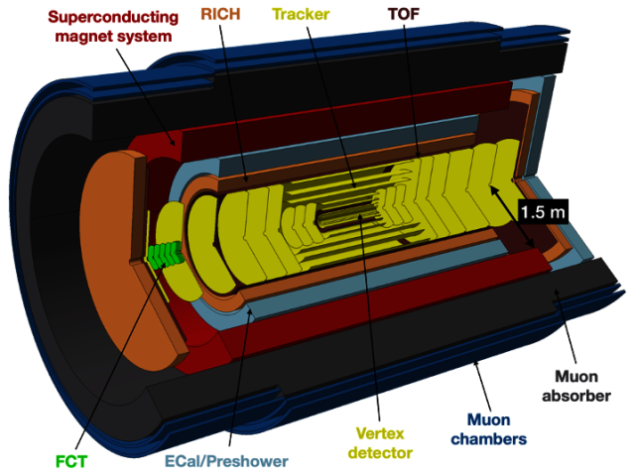
The ALICE detector has undergone significant overhauls during Long Shutdown 2 to prepare for the higher luminosities expected during Run 3 and 4 of the LHC, starting this year. Further upgrades of the inner tracking system and the addition of a new forward calorimeter are being planned for the next long shutdown, ahead of Run 4. A series of physics questions will still remain inaccessible with Run 3 and 4, and major improvements in the detector performance and an ability to collect an even greater integrated luminosity are needed to address them in Run 5 and beyond. The ideas for a heavy-ion programme for Run 5 and 6 are part of the European strategy for particle physics. At the beginning of 2020, the ALICE collaboration formed dedicated working groups to work out the physics case, the physics performance, and a detector concept for a next-generation heavy-ion experiment called “ALICE 3”.
To advance the project further, the ALICE collaboration organised a hybrid workshop on October 18 and 19, attracting more than 300 participants. Invited speakers on theory and experimental topics reviewed relevant physics questions for the 2030s, and members of the ALICE collaboration presented detector plans and physics performance studies for ALICE 3. Two key areas are the understanding how thermal equilibrium is approached in the quark-gluon plasma (QGP) and the precise measurement of its temperature evolution.
Restoring chiral symmetry
Heavy charm and beauty quarks are ideal probes to understand how thermal equilibrium is approached in the QGP, since they are produced early in the collision and are traceable throughout the evolution of the system. Measurements of azimuthal distributions of charm and beauty hadrons, as well as charm-hadron pairs, are particularly sensitive to the interactions between heavy quarks and the QGP. In heavy-ion collisions, heavy charm quarks are abundantly produced and can hadronise into rare multi-charm baryons. The production yield of such particles is expected to be strongly enhanced compared to proton-proton collisions because the free propagation of charm quarks in the deconfined plasma allows the combination of quarks from different initial scatterings.
Electromagnetic radiation is a powerful probe of the temperature evolution of the QGP. Since real and virtual photons emitted throughout the evolution of the system are not affected by the strong interaction, differential measurements of dielectron pairs produced from virtual photons allow physicists to determine the temperature evolution in the plasma phase. Given the high temperature and density of the quark-gluon plasma, chiral symmetry is expected to be restored. ALICE 3 will allow us to study the mechanisms of chiral symmetry restoration from the imprint on the dielectron spectrum.
New specialised detectors are being considered to further extend the physics reach
To achieve the performance required for these measurements and the broader proposed ALICE 3 physics programme, a novel detector concept has been envisioned. At its core is a tracker based on silicon pixel sensors, covering a large pseudo-rapidity range and installed within a new superconducting magnet system. To achieve the ultimate pointing resolution, a retractable high-resolution vertex detector is to be placed in the beampipe. The tracking is complemented by particle identification over the full acceptance, realised with different technologies, including silicon-based time-of-flight sensors. Further specialised detectors are being considered to further extend the physics reach.
ALICE 3 will exploit completely new detector components to significantly extend the detector capabilities and to fully exploit the physics potential of the LHC. The October workshop marked the start of the discussion of ALICE 3 with the community at large and of the review process with the LHC experiments committee.
Further reading
D Adamová et al. 2019 arXiv:1902.01211.





